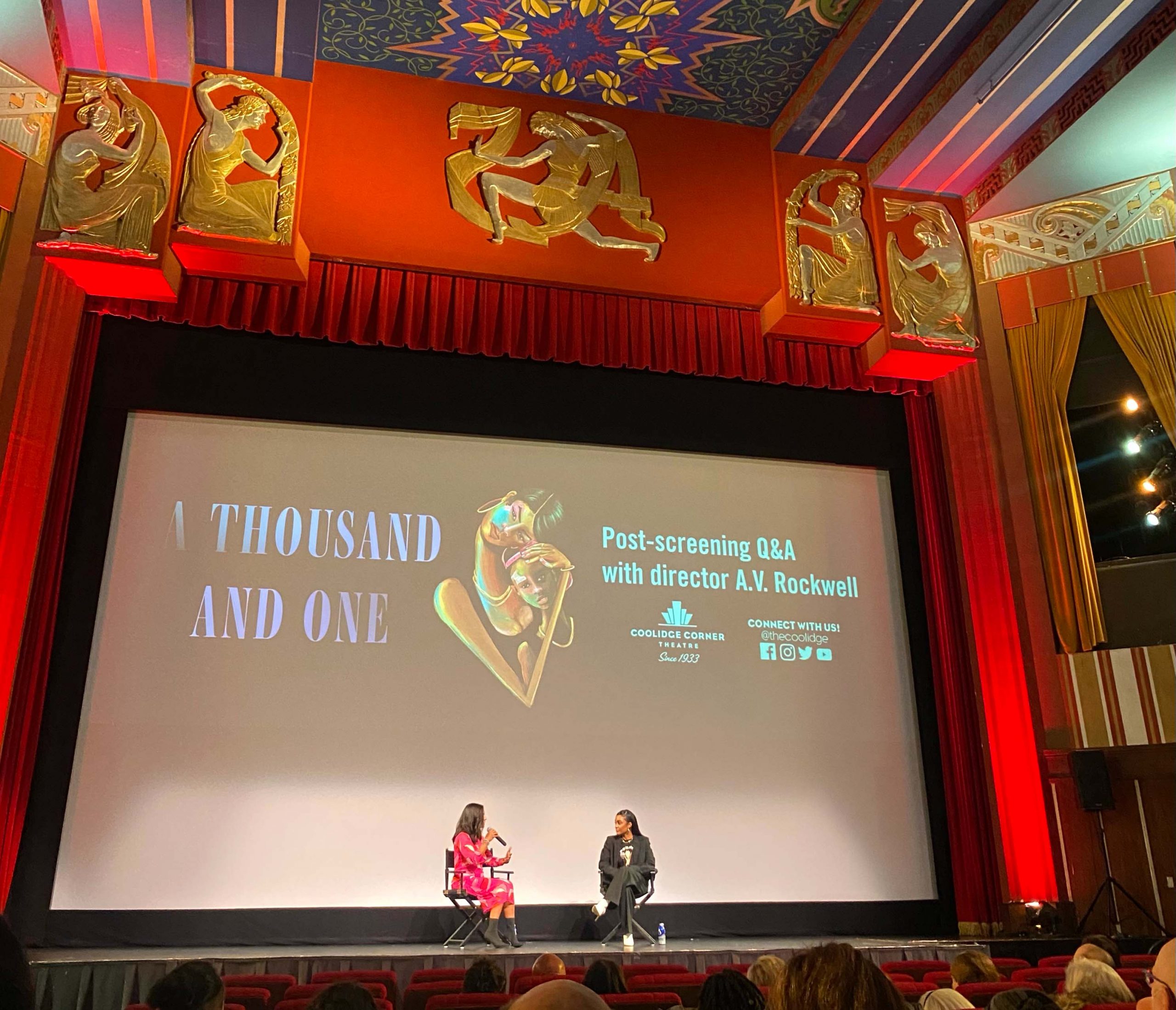A.V. Rockwell Discusses her debut feature, ‘A Thousand and One’

When filmmaker A.V. Rockwell debuted her feature, “A Thousand and One,” at the 2023 Sundance Film Festival, she ended up taking home the U.S. Dramatic Grand Jury Prize. The film explores a Black mother-and-son relationship rooted in unconditional love while also addressing the impact of systemic racism on urban communities. With this effort, Rockwell’s screenwriting and film direction constructs a heartfelt narrative of a family’s unceasing perseverance and willingness to give.
Applauded for an authentic and complex portrayal of Black perspectives, “A Thousand and One” joins a list of previous Sundance winners like “Nanny” (2022), “Fruitvale Station” (2013), and “Middle of Nowhere” (2012). Before premiering in theaters nationwide, the film was screened at Coolidge Corner Theatre in Brookline, MA, followed by an onstage Q&A with the director. While waiting backstage at the screening, Rockwell spoke to “The Independent” about her creative choices in the production and the inspirations behind her work.
When approaching this project, Rockwell, who grew up in New York City, asked herself, “How do I feel about the fact that this city doesn’t seem to love me?” and “What do I want to see as a storyteller?” She was sure to craft a script that amplified the voices of people of color. Rather than submitting to token Black character tropes, whose happy endings are often based on white lead trajectories, the characters in this film are told in a three-dimensional light, not simply as a means to support someone else’s story.
Set in Harlem in 1994, “A Thousand and One” opens with 22-year-old Inez, played by Teyana Taylor, hustling for work after her release from Rikers Island Correctional Facility, New York City’s largest jail. Back in Harlem and determined to give her six-year-old son, Terry, the stable home he needs, Inez makes a promise to him, saying, “I’ll go to war for you, against this whole city. They’re not breaking us up.” Growing up in the foster care system, too, Inez knew what it was like to be raised without familial love and security. To protect Terry from the same fate, she takes matters into her own hands to establish a family.
The film progresses through Inez and Terry’s lives in Harlem, but as gentrification creeps into their neighborhood during the late ‘90s, marginalized residents are impacted disproportionately. According to the U.S. Bureau of the Census, in 1990, 94 percent of Central Harlem’s population was composed of Black families, but by 2006, that statistic dropped to 69 percent despite the neighborhood’s increased total population. To further stress the shifting reality of New York, the film shows birds-eye montages of the borough’s skylines over the passing years, while in the background, headlines broadcast real-life mayoral speeches and the developing public policies of the decade. Fast forward to 2005, Inez and Terry face the threat of housing displacement and a rise in police violence, prompting them to seek stability as a family once again.
Backstage at the Coolidge Corner Theatre, Rockwell called herself “a New York kid” who felt her own community slowly being erased. This experience partially inspired “A Thousand and One.” She narrowed down the movie’s setting to Harlem, known as the “Black Mecca,” because of its rich Black history and culture. Worried over the fate of the city’s roots, she said, “To see that washed away … as a neighborhood changes dramatically, is a devastating loss for Black identity and heritage. To me, this movie is so much about protecting that.”
By illustrating Inez’s immovable determination to provide for her family, Rockwell drives her to take charge of her own destiny, no matter what the city throws her way. Even while keeping a harrowing secret that threatens her relationship with her son, Inez uplifts women along the way. The result Rockwell wants, she said, is for women of color to be seen for their whole selves, both in film and in real life. “I wanted to tell the story in a way that would celebrate and honor these women, especially these matriarchs of our community. … We may have superhero-like qualities, but we’re still ultimately human. We need to know that people are rooting for us and loving us.”
Inez’s character in “A Thousand and One” dismantles societal expectations for women to always be strong and resilient. In doing so, Rockwell prompts the question of who really is really fighting for Black women, who are so often made to feel misunderstood and invisible in society. By shedding light on her character’s flaws, as well as her triumphs, Rockwell captures a narrative where people of color are seen for their whole humanity and cherished for who they truly are.

Rockwell also discussed wanting to showcase the dynamics of relationships, particularly in rife situations of abandonment. Much of the film’s journey is about Terry growing up to not only figure out who he is as a man and who he will become, but to also ask himself, “Who am I to the women in my life?” As a masculine figure, his ability to access his vulnerability was important to Rockwell who wanted to defy stereotypes and move the audience to empathize with real experiences. “I was hoping that a movie like this would provide some level of healing and understanding,” she said.
In the Q&A that followed, audience member Andrea Lyman, a former social worker who worked in Harlem during the ‘90s, took to the mic to let Rockwell know, “Never for a second did I think this story was an unrealistic depiction of the messed up foster care system.” One-on-one later, Lyman explained how she used to think most children were in foster care because of abuse. Then she discovered that most foster care is because of neglect. If Terry hadn’t had his mother growing up, his life would’ve looked vastly different, creating a remarkably tense drama that leaves viewers both comforted and on edge by the end. “That’s why I can see the whole thing with Terry going missing [being real in the movie] because these things have been happening for a long time,” Lyman said.
The title, “A Thousand and One,” Rockwell said, isn’t just Inez and Terry’s apartment number, “It’s a play on words, about the group versus the individual. It was really about the uniqueness of New York, and the way it’s lost its sense of individuality, and how that change affected its citizens.” When gentrification infringes on underrepresented communities after failing to prioritize them, homes are stripped away from them, consequently causing feelings of isolation in the very same places people grew up in. The meaning of the title reflects how people like Inez and Terry feel when the odds are against them.
But in Rockwell’s hands, the odds are in their favor. “At the end of the day, this is a human story,” Rockwell expressed. “A Thousand and One” speaks to the continued fight for stability through a Black family’s journey as they redefine what their relationships mean with earnest love and hope.
